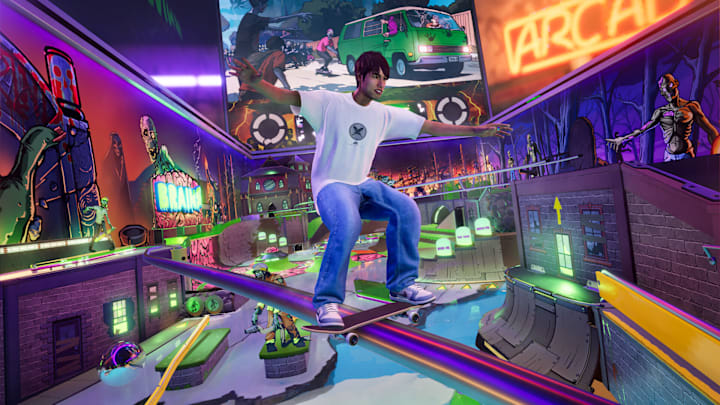Tony Hawk's Pro Skater 3+4 director says "the games influenced skaters to dream big"
By Ryan Woodrow

Tony Hawk’s Pro-Skater 3+4 remakes two legendary skateboarding titles, with THPS 3 in particular tied for third in the list of highest-rated games on Metacritic and generally being hailed as one of the greatest video games ever made. So, when it comes to remaking such a title, the pressure is high, but like with 1+2, the team proved to be up to the challenge. We spoke with Kurt Tillmanns, game director at Iron Galaxy Studios, about their approach to these remakes.
What’s unique about 3+4 compared to 1+2 is the inclusion of several new parks that weren’t in the original games, and Tillmanns explains that that’s all thanks to how Vicarious Visions (the developers for THPS 1+2) “absolutely crushed the gameplay. We knew that they had made a killer system,” and it wasn’t the intention to re-invent the wheel when Iron Galaxy Studios took the lead on development for 3+4. As Tillmanns describes it, “we wanted to make very targeted additions,” to enhance the feel of the game, which is why new content was such a big focus.
“The big thing with the classic parks is that they were built for the movesets that the skaters had at the time,” Tillmanns says. “So this is the first time players are going to get to play these parks with the full moveset that Vicarious Visions put together and we’ve added to. With the brand new parks, we have all the toys and tools to play with, plus, we’re making these levels in Unreal Engine 4, so we’re able to do things now that they weren’t able to in the past.
“We like to joke with Water Park that you’re basically able to see it from space, it’s such a massive level, so making something that big where you can get to the top of the slide and see across the entire park and plan out your combo line, that’s something they just weren’t able to do back in the day.”
It’s not just the advance of technology that pushed the team to make these levels bigger and better, though. Tillmanns says that “the games influenced skaters to dream big, and when they dream big, it pushes us to go to those places we wouldn’t have otherwise thought of,” and with roughly over two decades of progress and cultural shifts since the original games, the developers had plenty to work with when it came to inspiration for new environments and tricks.
“[The THPS games] set a great tone for how skaters were using the environment at the time, and as we move forward, obviously [Tony Hawk] is still around and he’s the ultimate paragon for skate culture, so he keeps us honest, makes sure we’re up to date and we’re using the right terminology, and all that good stuff, but there’s also new skaters. We bring in new pros, we bring in people that are hot in the scene today, and look at the things that influenced them. Where are they skating? What art are they into? How can that influence the street art that we put around the environment? We try to make sure we stay up to date with the culture.”
The culture around skating has shifted a lot since the late 1990s/early 2000s. Skating ended up heavily tied to the counter-culture punk-rock movements of the day, which led to the feeling that skaters were these cool rebels, with public officials trying to ban skaters from the streets. However, things are now a lot more accepted, and the games have shifted to reflect that – it’s hard to portray yourself as a rebel when you’re competing in the Olympics, after all.
“When the games first came out, [every NPC] was an authority figure telling you to stop skating,” Tillmanns says. “We still have some of that, but the tone is definitely more supportive now, there are a lot more NPCs that are like, ‘Hey, great combo! Keep going!’ and that feels more like what you’d do today if you were walking down the street and saw people skating.”
Another big change compared to when the original THPS games were releasing is that they aren’t the only game in town anymore. In the years since, series like the Skate games as well as indie offerings, have seen a lot of success, but THPS still holds a unique place in this genre that continues to grow.
“The interesting thing to me about [THPS] is that it still has its own vibe,” Tillmanns explains. “What interests me is that more skate games are going into simulation; it’s more about the mechanics of the flip on the control sticks that Skate started. We love that gameplay, but it solidifies for us that [THPS] lives in its own segment of that genre – it’s very arcadey and fast – it’s not about getting the micro-movements of the stick on the flip; you hit a button and you’re grinding, you look awesome. You can do a pretty simple set of button inputs, and all of a sudden, you look like a rockstar.”
With both 1+2 and 3+4 being highly well-received remakes, it’s led fans to wonder whether the door is open for a new wholly original THPS game, especially now 3+4 has shown us what kind of levels can be created with modern design tools and ideas. While the disaster that was THPS 5 pretty much killed the series in 2015, these remakes have reignited a passion for the games that could be capitalized on, and while Tillmanns couldn’t give us anything more than “I hope so,” when asked about a new title, the tone around the series is one of great optimism.